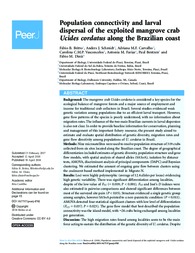Population connectivity and larval dispersal of the exploited mangrove crab Ucides cordatus along the Brazilian coast.
Population connectivity and larval dispersal of the exploited mangrove crab Ucides cordatus along the Brazilian coast.
Author(s): BRITTO, F. B.; SCHMIDT, A. J.; CARVALHO, A. M. F.; VASCONCELOS, C. C. M. P.; FARIAS, A. M.; BENTZEN, P.; DINIZ, F. M.
Summary: Abstract: Background: The mangrove crab Ucides cordatus is considered a key species for the ecological balance of mangrove forests and a major source of employment and income for traditional crab collectors in Brazil. Several studies evidenced weak genetic variation among populations due to an efficient larval transport. However, gene flow patterns of the species is poorly understood, with no information about migration rates. The influence of the two main Brazilian currents in larval dispersion is also not clear. In order to provide baseline information for conservation, planning and management of this important fishery resource, the present study aimed to estimate and evaluate spatial distribution of genetic diversity, migration rates and gene flow directivity among populations of U. cordatus in Brazil. Methods:Nine microsatellites were used to resolve population structure of 319 crabs collected from six sites located along the Brazilian coast. The degree of geographical differentiation included estimates of genetic diversity, population structure and gene flow models, with spatial analysis of shared alleles (SAShA), isolation by distance tests, AMOVA, discriminant analysis of principal components (DAPC) and Bayesian clustering. We estimated the amount of ongoing gene flow between clusters using the coalescent-based method implemented in Migrate-N. Results:Loci were highly polymorphic (average of 12.4 alleles per locus) evidencing high genetic variability. There was significant differentiation among localities, despite of the low value of FST (= 0.019; P < 0.001). FST and Jost's D indexes were also estimated in pairwise comparisons and showed significant differences between most of the surveyed site pairs (P < 0.05). Structure evidenced a single genetic group among samples, however SAShA pointed to a non-panmictic condition (P = 0.011). AMOVA detected four statistical significant clusters with low level of differentiation (FCT = 0.037; P = 0.023). The gene flow model that best described the population connectivity was the island model, with ?24 crabs being exchanged among localities per generation.DIscussion:The high migration rates found among localities seem to be the main force acting to sustain the distribution of the genetic diversity of U. cordatus. Despite the high gene flow and the weak population structure among samples, the significant genetic differences found suggest that gene flow alone does not bypass the effects of genetic drift, natural selection and/or human exploitation. These findings are vital for the establishment of a database to be used in the development of conservation programs.
Publication year: 2018
Types of publication: Journal article
Unit: Embrapa Goats & Sheep
Observation
Some of Embrapa's publications are published as ePub files. To read them, use or download one of the following free software options to your computer or mobile device. Android: Google Play Books; IOS: iBooks; Windows and Linux: Calibre.
Access other publications
Access the Agricultural Research Database (BDPA) to consult Embrapa's full library collection and records.
Visit Embrapa Bookstore to purchase books and other publications sold by Embrapa.

